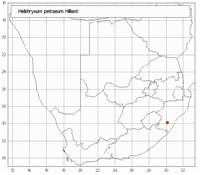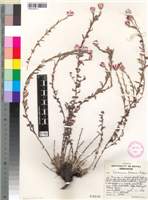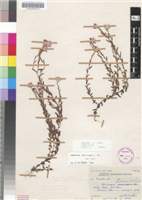Origin of name:
petraeum = rock loving
Diagnostic characters:
Flimsy herbaceous plantLarge solitary headsWhite / maroon bracts
Description:
Perennial herb, stock woody, crowned with several leaf rosettes, flowering stems lateral, decumbent, up to 450 mm long, loosely branched, loosely woolly, leafy. Radical leaves c. 30�50 x 2�4 mm, linear or linear-lanceolate, apex acute or subacute, mucronate, base broad, papery, clasping, purplish when young, both surfaces grey-woolly; cauline leaves c. 10�20 x 2�3 mm, oblong-lanceolate, acute, mucronate, base slightly narrowed, half-clasping, both surfaces loosely woolly, glandular-setose, wool glabrescent. Heads heterogamous, campanulate, 10 mm long, about twice that across the radiating bracts, solitary at the branch tips, the whole forming a very open corymbose panicle. Involucral bracts in c. 10 series, loosely imbricate, much exceeding the flowers, glossy, acute, white, tipped crimson. Flowers c. 120�230, 18�32 female, 118�195 homogamous, yellow, sometimes tipped crimson. Achenes not seen, ovaries with myxogenic duplex hairs. Pappus bristles several, barbellate above, nude below, bases not cohering.
Flowering in March and April.
Distribution:
Grows around the edges and in the crevices of rock sheets in grassland. Recorded from Mbabane district in Swaziland, Nkandla, Mpendhle and Richmond districts in KwaZulu-Natal.
Grassland and Savanna Biomes.
Notes:
Easily confused with H. adenocarpum, but readily distinguished by its linear radical leaves and small heads.
Taxonomy:
Literature:
Helichrysum petraeum Hilliard in Notes R. bot. Gdn Edinb. 40: 263 (1982).
Type:
KwaZulu-Natal, Richmond distr., ridge leading to Peak of Byrne, c. 1 525 m, 29 iv 1976, Hilliard 8092 (NU, holo.; E; K; M; MO; PRE; S, iso.).
Synonym(s):
Vouchers:
Compton 25862 (M; PRE); Galpin 11939 (BOL; PRE); Stewart 2056 (E; K; MO; NU); Wood 9923 (BOL).



